Atwater Roof Damage by Weather Conditions and Insurance Claims - A Comprehensive Guide
The safety and security of your home, your personal sanctuary, heavily depend on the condition of your roof. But what happens when unforeseen roof damage by weather conditions occurs? Understanding the diverse types of damage caused by natural elements, navigating the intricacies of the insurance claim process, and adopting effective roof maintenance practices are crucial elements in safeguarding your investment.
This comprehensive guide serves as your companion, guiding you through the essentials and empowering you to protect your home confidently in the face of both “roof damage by weather conditions and insurance claims.”
In Atwater, roof damage resulting from severe weather conditions such as storms, high winds, tornadoes, and hail is a recurrent challenge, and Pine Ridge Roofing is ready to provide assistance.
Key Takeaways
Table of Contents
Atwater Roof Damage - Types of Weather-Related Roof Damage
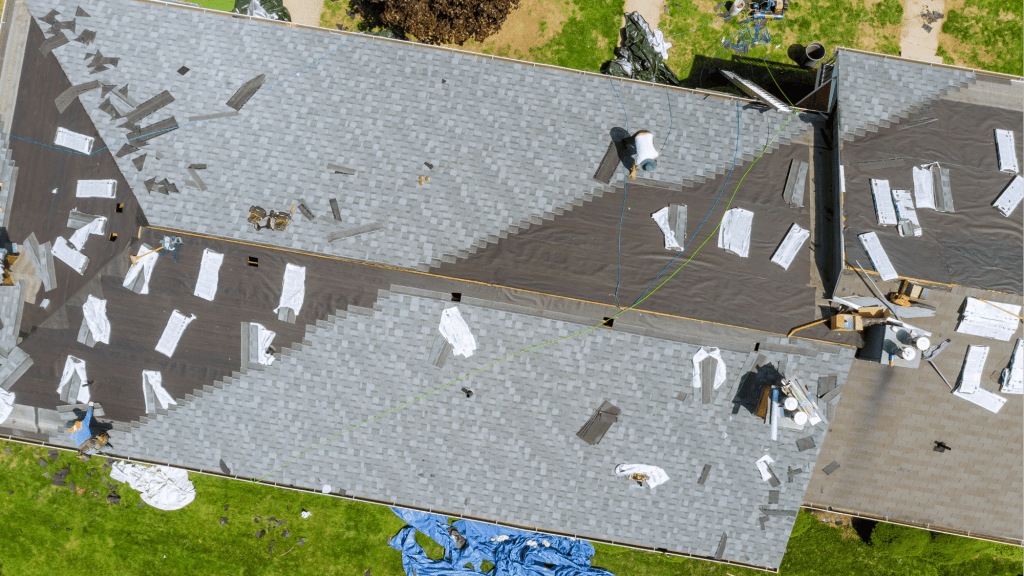
In Atwater, roof damage by weather conditions is really common. Weather can be unpredictable, and it can wreak havoc on your roof. Wind, hail, and rain or snow are the most common culprits of weather-related roof damage, often leading to insurance claims and costly repairs or replacements.
Protecting your home requires recognizing the signs of storm damage and comprehending how these forces impact your roofing materials.
Is roof damage covered by insurance? For home insurance to provide coverage for your roof damage expenses, it is essential to establish that the damage was a direct result of an extreme weather event.
Wind Damage
In Atwater, roof damage caused by high winds can silently jeopardize the condition of your roof. This damage may manifest as missing shingles, lifted flashing, or cracked tiles, and in severe cases, it might result in the complete displacement of the roof. Despite appearing minor initially, these damages can escalate over time, leading to leaks and structural issues that necessitate initiating the roof insurance claim process.
Repairing an older roof introduces challenges, particularly with less flexible and prone-to-cracking shingles. It is imperative to involve a qualified roofing specialist for a meticulous roof inspection and to promptly address any damage.
Gaining insight into the wind insurance coverage specifics in your homeowner’s insurance policy is pivotal for preparedness, especially during adverse weather conditions such as storms.
Wind damage can stem from various weather events, including severe storms or hurricanes. Consistently monitoring your roof’s condition post such events is essential, and taking swift action upon observing visible signs of wind damage is critical. If, for instance, a sizable tree branch is discovered on your roof, it is advisable to have it professionally removed to prevent further damage and potential roof damage claims.
Hail Damage
When hailstorms hit, they can cause widespread damage, leaving shingles with dents, punctures, and granule loss. Although this damage might go unnoticed by the untrained eye, its repercussions for your roof’s durability and functionality are significant. Hail has the potential to bruise or crack the shingle mat, opening the door for water to gradually enter your home and potentially leading to a necessary roof claim.
Roof inspection for hail damage can be challenging, especially after a storm. Insurance adjusters and roofing professionals often consider metal components surrounding the roof, such as:
- Roof vents
- Pipe boots
- Gutters
- Roof flashing
It is important to emphasize that inspecting the roof immediately after a storm, especially if it has a steep slope, is not recommended. In cases of substantial hail damage, taking immediate action, such as applying tarps to the roof, becomes crucial to prevent further damage from rainwater.
Rain and Snow Damage
Rain and snow may seem harmless, but they can wreak havoc on your roof if not properly managed. Here are some potential issues caused by rain and snow:
- Leaks and water damage
- Structural issues
- Roof collapse due to the weight of accumulated snow
- Ice dams, which can damage your roof and gutters
It’s important to take steps to protect your roof from these potential problems.
Employing preventative tactics, such as regular inspections, ensuring ample ventilation, and effective waterproofing, is crucial to protect your property from the damaging effects of rain and snow. Stay ahead by actively managing your roof’s maintenance and gaining insight into homeowner’s insurance coverage options like Actual Cash Value (ACV) and Replacement Cost Value (RCV) policies, thereby reducing the likelihood of facing substantial expenses for repairs or replacements caused by weather-related damage.
Atwater Roof Damage - Insurance Coverage for Weather-Related Issues
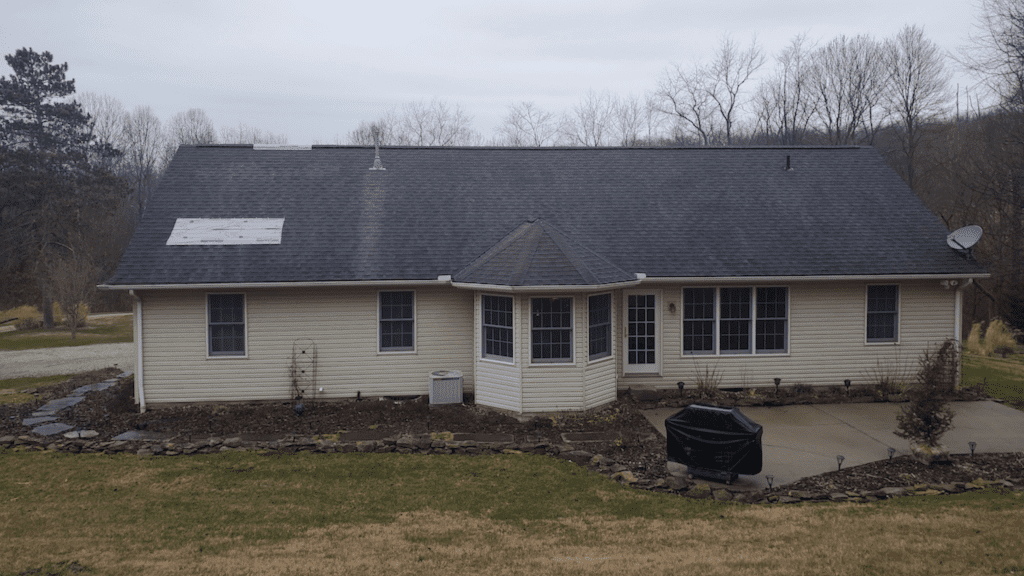
Safeguarding your home from unexpected roof damage in Atwater, Ohio, relies heavily on the insurance company’s role in offering crucial financial protection. Navigating the intricacies of insurance coverage, though, can be a challenging task. A profound comprehension of policy distinctions, such as Actual Cash Value (ACV) and Replacement Cost Value (RCV), coupled with an awareness of common exclusions, can substantially impact how your claim is managed and ultimately resolved.
Policy Types: ACV vs RCV
An Actual Cash Value (ACV) policy offers coverage for the replacement of your roof. It reimburses you the depreciated value, deducting the applicable deductible. In other words, you’ll receive compensation for the current value of your roof at the time of the damage, which may not be enough to cover the full cost of repairs or replacement.
On the other hand, a Replacement Cost Value (RCV) policy offers replacement cost coverage, which means that it covers the cost of roof replacement, providing funds for a new roof based on current prices and materials. With an RCV policy, you’ll initially receive a check for the actual cost value of your roof, and upon completion of the roof replacement, a second check for the remaining amount will be issued, provided you have met all requirements.
The choice of a suitable policy for your needs can greatly impact the payout you receive in the event of a roof damage claim, making it an important decision. It is essential to:
- Review your insurance policy
- Understand the differences between ACV and RCV
- Consult with your home insurance company to ensure you have the appropriate coverage for your specific situation.
Common Exclusions
Preserving your home from weather-induced roof damage in Atwater, OH, with homeowners insurance is a wise move, but being mindful of common exclusions is equally crucial for a seamless claims process, such as:
- Improper installation, deviating from manufacturer instructions or local building codes, is a typical exclusion that can hasten wear and tear, potentially voiding your roof’s warranty.
- Neglecting routine maintenance, such as clearing gutters and removing debris, might result in damages not covered by your policy.
- Some policies may also exclude specific weather events, like hurricanes or earthquakes.
A comprehensive review of your insurance policy is essential to understand these exclusions and secure proper coverage for your roof. Inadequate maintenance occurs when regular inspections and maintenance, following manufacturer guidelines and local codes, are overlooked, possibly causing premature deterioration and voiding warranties.
Understanding these exclusions and ensuring proper roof installation, maintenance, and protection against excluded weather events are critical steps to avoid potential claim denials. Staying informed and taking a proactive approach to roof care can minimize the risk of expensive repairs or replacements due to weather-related damage.
Atwater Roof Damage - Filing an Insurance Claim
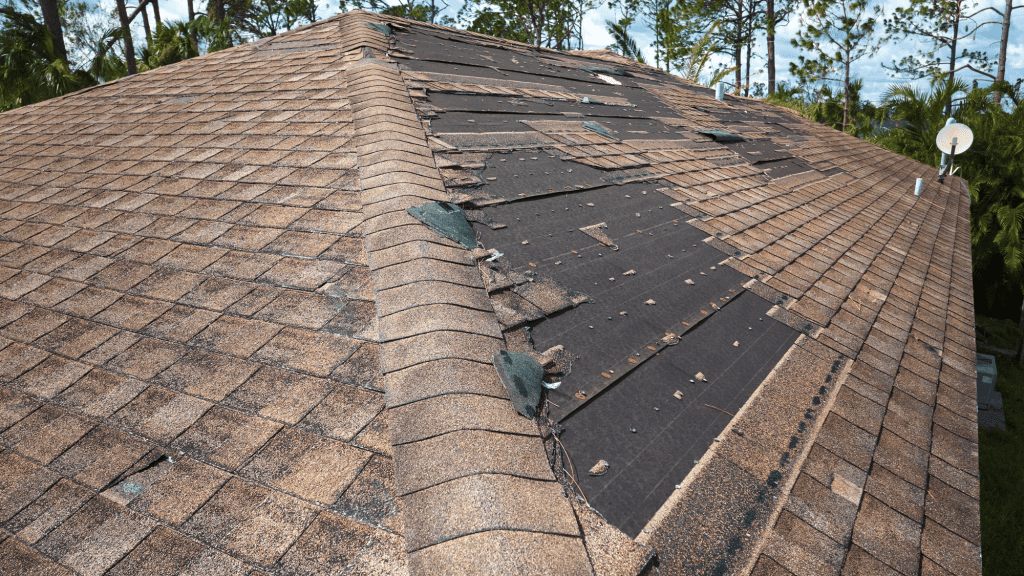
The journey of filing an insurance claim for roof damage in Atwater, Ohio, necessitates a nuanced and well-informed approach. Effectively documenting the damage, fostering a collaborative relationship with insurance adjusters, and making prudent decisions regarding roofing contractors are pivotal to a seamless claims process.
This comprehensive guide is designed to lead you through the necessary steps and provide valuable tips, ensuring a smooth and successful insurance claim experience.
Documenting the Damage
Thorough documentation is a key aspect when initiating an insurance claim for roofing damage. Here’s a guide to follow:
- Photograph the affected areas extensively, focusing on any missing shingles, raised flashing, or damaged tiles.
- Create a comprehensive list of the damage, accompanied by detailed notes, including dates, times, and relevant weather conditions contributing to the damage.
- If preventive measures have been implemented, such as using tarps on the roof, document these measures through photographs.
Following the documentation process, seek an estimate from a certified roofing contractor to determine the cost of repairs or replacement. This estimate not only provides clarity on the damage extent but also serves as crucial documentation when presenting your claim to the insurance company. Maintaining a thorough and precise record of the roofing damage significantly enhances the chances of a successful claim.
Working with Adjusters
In Atwater, roof damage insurance adjusters play a vital role in the claims process, evaluating the extent of damage and determining the value of your claim payout. Collaborating effectively with adjusters is crucial for achieving the best possible outcome for your claim. Providing precise information, maintaining meticulous records of all communications and documents related to the claim, and ensuring transparency throughout the process are essential steps.
If your claim faces denial, you have several avenues for resolution:
- Firstly, consider requesting a different adjuster from your insurance company to obtain a second opinion.
- Alternatively, consulting a structural engineer for a thorough inspection and evidence of the damage can strengthen your case.
- As a last resort, legal options can be pursued.
By comprehending the adjusters’ role and being well-prepared to collaborate with them, you significantly enhance the chances of a successful claim. This approach ensures you receive the necessary coverage to repair or replace your roof damaged in Atwater.
Choosing a Reputable Roofing Contractor
Selecting a reliable roofing contractor is key to ensuring quality work and a streamlined insurance claims process. When researching roofing contractors for insurance claims, it’s crucial to evaluate their experience with claims, turnaround times, and their ability to collaborate with adjusters. A skilled roofing contractor can accurately document damage as per the requirements of insurance companies and provide an expert assessment.
Opting for a local and trustworthy roofing contractor, such as Pine Ridge Roofing, provides assurance that your roof repair or replacement is in capable hands. Their team of certified roofers and insurance specialists is ready to assist with storm repair, restoration, and insurance claims in Atwater, Ohio, and the surrounding regions. Choosing an experienced roofing contractor ensures the safety and integrity of your home.
Atwater Roof Damage - Preventative Measures and Maintenance
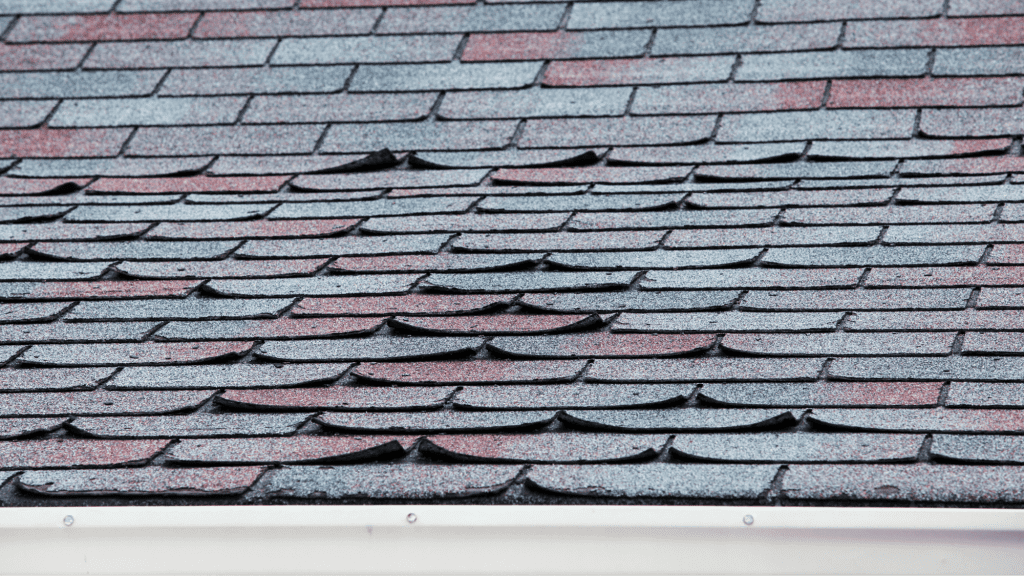
Safeguarding your home from the financial impact of weather-related roof damage, insurance offers a crucial safety net. Yet, to truly fortify your defense against costly repairs, it’s essential to adopt preventive strategies. Regular inspections, proper ventilation, and effective waterproofing emerge as key players in maintaining your roof’s robust condition. By incorporating these measures, you not only reduce the risk of weather-related damage but also enhance the longevity of your roofing structure.
Routine Inspections
Regular roof inspections serve as an effective method to spot and tackle potential issues before they escalate into significant problems. Inspections should evaluate the roof for signs of:
- Deterioration
- Missing or damaged shingles
- Debris in the gutters
- Roof ponding
Maintaining your roof’s health requires regular inspections, especially in areas exposed to extreme weather. Conduct these inspections at least bi-annually to stay ahead of potential issues.
Being proactive in addressing minor problems can save you significant money by preventing the need for costly repairs or a full roof replacement. Pine Ridge Roofing, a trusted contractor, offers free roof inspections to assess and maintain your roof’s integrity. Call us today to schedule your inspection and secure the long-term health of your roof.
Proper Ventilation and Waterproofing
Shielding your roof from the adverse effects of moisture buildup, ice dams, and other weather-related damage requires a focus on proper ventilation and waterproofing. This includes:
- Maintaining good indoor air quality
- Implementing effective home ventilation strategies
- Utilizing exhaust fans and air purifiers
- Installing a reliable ventilation system
- Ensuring the correct attachment of roof ventilation products.
Neglecting these aspects may result in problems like moisture accumulation and ice dams, potentially leading to costly repairs and replacements. Prioritizing adequate roof ventilation and waterproofing is key to reducing the risk of damage and prolonging the performance and lifespan of your roofing materials.
Pine Ridge Roofing: Your Partner in Roof Repair and Insurance Claims
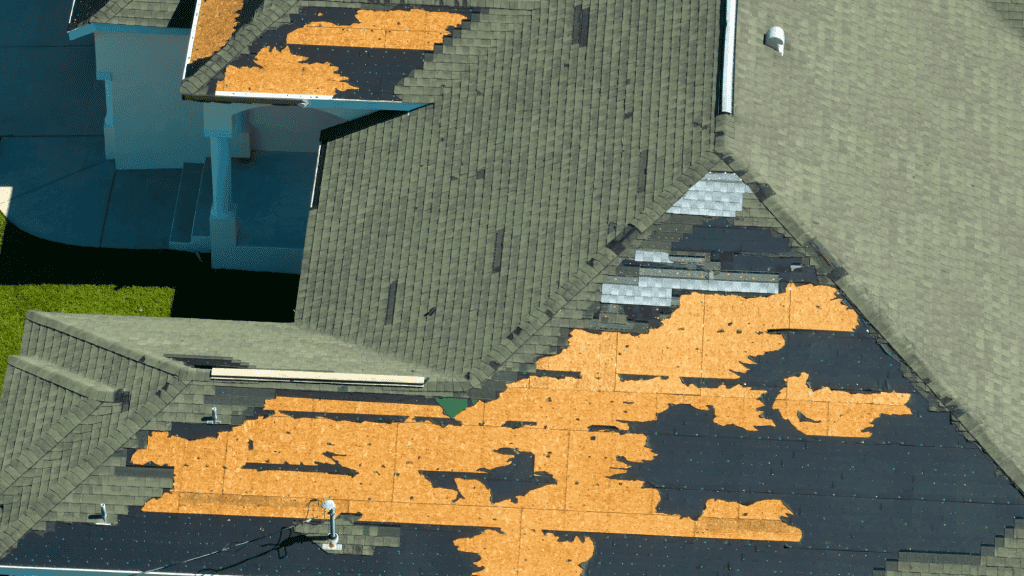
Pine Ridge Roofing, serving Atwater, Ohio, and surrounding areas, specializes in:
- Storm damage repairs
- Insurance claims
- Emergency inspection
- Tarping services
- Assistance with insurance claims for weather-related roof damage
- Roof replacements
- Siding repair and replacement
- Gutter repair and replacement
- Leaf Guard Installation
- Deck building
For over 25 years, our team, comprised of certified roofers and insurance specialists, has been steadfast in delivering top-tier roof repairs. Our mission is to protect and restore your home in the aftermath of weather-related damage events.
Emergency Inspection and Tarping Services
When you suspect roof damage, scheduling a free emergency inspection with Pine Ridge Roofing can help you assess the extent of the damage and determine the best course of action for repairs or replacement. Our team of professionals will conduct a thorough evaluation of your roof, identifying any missing shingles, lifted flashing, or cracked tiles that may require immediate attention.
In addition to emergency inspections, Pine Ridge Roofing offers the following services:
- Tarping services provide temporary protection and prevent any further damage to your roof
- Acting quickly and securing your roof with tarps to minimize the risk of additional damage
- Ensuring your home remains safe and secure throughout the insurance claim process
Insurance Claim Assistance
Navigating the insurance claim process can be overwhelming, but Pine Ridge Roofing is here to help. They offer the following services:
- Assisting with insurance claims
- Representing homeowners
- Negotiating with insurance companies
- Providing quality roof replacement services
When it comes to insurance claims, Pine Ridge Roofing’s expertise guarantees the best possible outcome, allowing you to prioritize your family’s safety and well-being. Their insurance claim assistance includes:
- emergency inspections
- tarping damaged areas
- representing homeowners during insurance adjuster meetings
- negotiating with insurance companies
- utilizing top-notch products such as Owens Corning shingles and synthetic felt for roof replacements.
With Pine Ridge Roofing, you can trust that your roof repair or replacement will be handled professionally and efficiently, ensuring the protection of your home.
Summary
Coping with weather-related roof damage in Atwater, OH can be overwhelming for any homeowner. The key lies in understanding the nuances of damage, effectively maneuvering through the insurance claim procedure, and implementing preventative measures for roof maintenance. This comprehensive guide empowers you with insights. With the support of Pine Ridge Roofing, a reputable contractor, you can confront weather-related roof issues with assurance, safeguarding your home and family.
Frequently Asked Questions
Does Home Insurance Cover Roof Storm Damage?
The coverage of roof storm damage by home insurance depends on the specifics of your policy. Typically, many insurance plans provide coverage for damage resulting from hail, wind, the destruction caused by falling objects, and interior damage due to roof storm damage. For example, if a storm leads to the destruction of your roof and subsequent rainwater damage to the ceiling, your insurance policy will generally cover the repairs to both the roof and ceiling.
Are blown-off shingles covered by insurance?
Insurance providers generally acknowledge the significance of a sturdy roof, often offering coverage for the expenses associated with replacing a roof damaged by unforeseeable events, such as the loss of shingles.
What is considered wind damage to shingles?
The aftermath of strong winds often manifests in shingle damage, presenting as tearing, creasing, or outright detachment from the roof. In the case of three-tab shingles, the risk escalates due to repeated lifting or flapping. It’s crucial to recognize that unsealed shingles remain resilient unless subjected to evident physical mat damage.
My roof doesn’t leak. Does this mean my roof is okay?
Just because your roof doesn’t exhibit leaks, it doesn’t necessarily indicate that your roof is in perfect condition. In numerous instances, roof damage isn’t immediately visible, and leaks might not manifest during the next rainfall. Concealed damage can persist unnoticed for an extended period. Skilled roofing professionals, as we have at Pine Ridge Roofing, possess tools and techniques that enable them to identify moisture beneath roofing materials and identify areas of damage that might otherwise go unnoticed. Schedule your free inspection now!
What is the most common roof damage?
Roof damage in Atwater, OH frequently manifests as leaks, typically attributed to issues like damaged shingles, improper flashing near chimneys or gutters, and surrounding vents or pipes.













